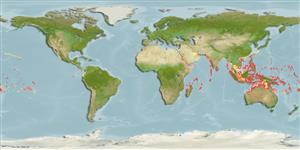>
Holocentriformes (Squirrelfishes, soldierfishes) >
Holocentridae (Squirrelfishes, soldierfishes) > Holocentrinae
Etymology: Sargocentron: Greek, sargos = sargus + Greek, kentron = sting (Ref. 45335).
More on author: Bleeker.
Issue
Ref. 559, 2334, 4201
Environment: milieu / climate zone / depth range / distribution range
Ecologia
marino associati a barriera corallina; distribuzione batimetrica 0 - 100 m (Ref. 90102), usually 0 - 15 m (Ref. 90102). Tropical; 30°N - 21°S
Indo-Pacific: East Africa (except the Red Sea) to the Line and Society Islands, north to Ryukyu and Wake Islands, south to Vanuatu; throughout Micronesia.
Size / Peso / Age
Maturity: Lm ? range ? - ? cm
Max length : 19.5 cm TL maschio/sesso non determinato; (Ref. 90102)
Spine dorsali (totale) : 11; Raggi dorsali molli (totale) : 12 - 14; Spine anali: 4; Raggi anali molli: 9 - 10. Body silvery pink with longitudinal red stripes; head red with silvery reflections on the cheek and opercle; spinous dorsal pink (or light red) with submarginal dark red band, the membranes tipped in white; other fins red to yellowish red, with the upper and lower edges of the caudal fin darker red; leading edges of anal and pelvic fins white with a submarginal darker red band, base of pectoral fins darker red (Ref. 4201 and 27370). Four oblique scale rows on cheek; body depth 2.6-2.9 in SL; head length (HL) 2.6-2.85 in SL; snout length 3.45-3.95 in HL; mouth often terminal; maxilla extending to between verticals just short of front of the pupil and just about center of the eye, upper jaw length 2.45-2.6 in HL; premaxillary groove reaching to a vertical at front edge of the orbit; anterior end of nasal bone with 2 short diverging spines; surface and medial margin of nasal bone spineless; moderately large nasal fossa often spineless on margin (an 11.8 cm SL specimen from Comoros, ROM 56585, has 2 spinules on the edge of the fossa, one on each side; a 9.4 cm, FMNH 17947, has a small spinule on one side on the edge of the fossa); upper edge of suborbital bones uniformly serrate; preopercular spine about 2/3 orbit diameter, 3.8-4.7 in HL; opercular spines 2, the lower from 2/3 as long to nearly as long as upper spine; short dorsal spines, 3rd to 5th dorsal spines subequal, 4th usually longest, 2.25-2.7 in HL; 3rd anal spine 1.25-1.6 in HL (Ref. 27370).
Found in relatively deep waters of outer reef slopes and has been collected on reef flat and lagoon patch reefs. Feeds mainly on benthic crabs and shrimps at night. Spine of preopercle venomous. Maximum depth reported taken from Ref. 128797.
Life cycle and mating behavior
Maturità | Riproduzione | Deposizione | Uova | Fecundity | Larve
Randall, J.E., 1998. Revision of the Indo-Pacific squirrelfishes (Beryciformes: Holocentridae: Holocentrinae) of the genus Sargocentron, with descriptions of four new species. Indo-Pac. Fish. (27):105 p. (Ref. 27370)
IUCN Red List Status (Ref. 130435: Version 2024-2)
Human uses
Strumenti
Special reports
Download XML
Fonti Internet
Estimates based on models
Preferred temperature (Ref.
123201): 26.6 - 29.3, mean 28.5 °C (based on 2259 cells).
Phylogenetic diversity index (Ref.
82804): PD
50 = 0.5000 [Uniqueness, from 0.5 = low to 2.0 = high].
Bayesian length-weight: a=0.01660 (0.00788 - 0.03495), b=2.97 (2.80 - 3.14), in cm total length, based on LWR estimates for this Genus-body shape (Ref.
93245).
Trophic level (Ref.
69278): 3.6 ±0.60 se; based on food items.
Resilienza (Ref.
120179): Alto, tempo minimo di raddoppiamento della popolazione meno di 15 mesi (Preliminary K or Fecundity.).
Fishing Vulnerability (Ref.
59153): Low vulnerability (10 of 100).
Nutrients (Ref.
124155): Calcium = 67.6 [26.8, 261.3] mg/100g; Iron = 0.565 [0.226, 1.727] mg/100g; Protein = 18.6 [17.4, 19.8] %; Omega3 = 0.154 [0.067, 0.351] g/100g; Selenium = 32.9 [19.5, 62.5] μg/100g; VitaminA = 75.8 [29.2, 207.5] μg/100g; Zinc = 1.98 [0.82, 3.73] mg/100g (wet weight);
